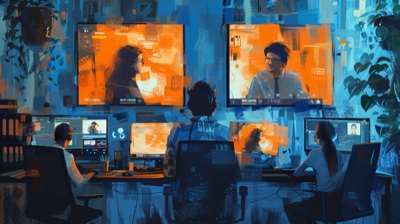Why branding, CI and culture matter in virtual offices
Use brand and corporate design to develop an intact corporate culture in the hybrid office and remain recognizable to employees and customers.

Remote and hybrid work came with many benefits, but also many challenges.
One of the most unexpected challenges was to keep the brand image, corporate identity and culture while transitioning hybrid or remote work. It’s clear that relying on 3rd party videoconferencing software such as Zoom or Webex makes every business look similar to employees, clients or partners - and that’s exactly what companies don’t want.
Interacting with clients and partners: Brand image is important
While the product or service offered will ultimately make a client stick with your business, brand image is the one that creates a first impression. Just like people judge books by their cover, they also judge businesses by their brand image. We all know from personal experience how powerful first impressions are.
Businesses had their brand image well-developed before the pandemic. Every office was decorated to fit their brand, business cards were created to make a lasting first impression, and every element the companies used to get in touch with their clients was well-designed.
With the pandemic, many touchpoints companies used to serve have moved from the physical world to the digital space. And in this digital space, most companies used the same software as everyone else and that meant brand image was diminished or lost.
Let’s take the example of a law firm. When a lawyer invites a prospect to their physical office, it’s easy to inspire professionalism, success, and trustworthiness with the help of architecture, materials and furniture in the office. Inviting a prospect to a meeting on Zoom or MS Teams is like inviting him to a sublead / Regus office with an improvised company nameplate. With the traditional videoconferencing tools it’s much harder to create the same powerful impression as renowned law firms in their physical offices.
Beyond the example, in an ocean of businesses competing for the same market, brands need to stand out and be remembered, which is very hard to do in a software branded by its provider. As hybrid work is going to stay and more and more cross-company touchpoints will move to the digital space, businesses can’t afford to miss out the opportunity of communicating brand and corporate identity there as well.
Company culture is lost with videoconferencing apps
Brand, corporate identity and design are equally important when it comes to corporate culture and identity. Businesses spent a lot of time and effort to decorate their physical offices in a way that not only reflects their vision, but enhanced it.
If you worked at a fun company in a young industry such as video games, you’d have game rooms, pool tables, and other cool things that made the company culture fun and exciting. If the company was a marketing agency working for celebrities and other important people, you’d see pictures with their most famous clients hanging around the offices. The same distinctive design elements could be found on any type of business, either if we talk about a lawyer’s office or a private clinic.
Again, businesses lost this distinctive element shaping their company culture when they had to use videoconferencing apps such as Zoom, Microsoft Teams, and Webex. One of the reasons behind the “great resignation” is that workers thought it wouldn’t matter any longer for which company they work on MS Teams. Loyalty to the company was lost, employers became interchangeable - among other things, because employees were not confronted with the many elements that shape corporate culture and the sense of belonging, from visual elements such as logos and CD to ways of designing the immediate environment (e.g., furnishing the office). No company wants to risk such a deterioration in employee loyalty in times of a shortage of skilled workers.
And since hybrid work is the future of work, businesses need a solution to keep their brand image for the sake of their employees and clients as well.
ivCAMPUS helps you keep your brand and corporate identity in the virtual office
ivCAMPUS is more than a virtual office. It’s an immersive virtual space where people work together, collaborate, and interact in real-time, just like they would do in a real office. And we designed it in such a way to allow you to not only keep your brand image but also let employees feel attached to their virtual office and your company.
From colors to logos, areas and rooms - ivCAMPUS is fully customizable with a few clicks. You can bring back the design you had in the physical office to keep your company culture intact and connect with your customers and employees on an emotional level. External visitors are received in a beautiful reception area. Employees not only see the visual brand elements but are an active part of their own workplaces design and structure.
Now you can enjoy the advantages of having your brand image even if you adopt a remote or hybrid work model.




